News
Biohabitats Opens Northeast Highlands & Coastal Bioregion Office
The innovative, nature-based solutions you’ve come to expect from Biohabitats are now even easier for clients in the New England area to access! We have just opened a Northeast Highlands and Coastal Bioregion office in Glastonbury, Connecticut. Led by fisheries/water resources engineer and dam removal expert, Laura Wildman, the new office provides Biohabitats’ full array of services to help you restore ecosystems, conserve and protect habitat, and regenerate the natural systems that sustain all life on Earth. For more information about our new office, please contact Laura Wildman.

Projects
Exciting dam news!
We are excited to be involved in several stream and river restoration projects in the Eastern U.S. involving the removal of 10 dams. The projects extend as far as the Great Lakes and the bold coast of Maine, on waterways that include tributaries of Virginia’s Rappahannock River and New York’s mighty Hudson. We look forward to sharing updates on these projects in the coming months!
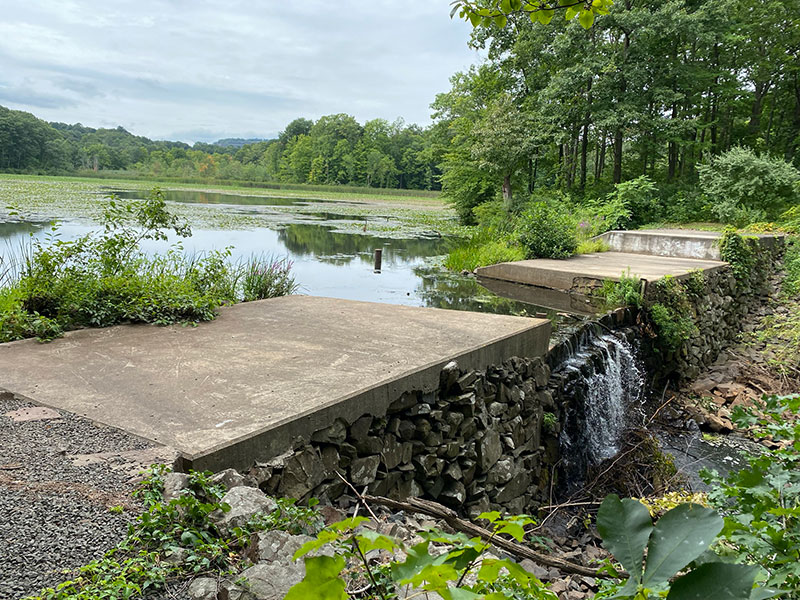
Ditching Degraded Stream Conditions in Ohio
Last May construction wrapped on the restoration of Beaver Creek in Munson Township, Ohio. The creek flows into the Glacially-formed Bass Lake, an Ohio EPA-designated Exceptional Warmwater Habitat and the headwaters State Scenic Chagrin River. Previously channelized to accommodate agriculture, the creek was disconnected from its floodplain, highly eroded, and inundated with invasive vegetation. Thanks to a great partnership with Geauga Park District and Meadville Land Service, and funding from the Ohio EPA Water Resource Restoration Sponsor Program, Beaver Creek is quickly bouncing back to life.
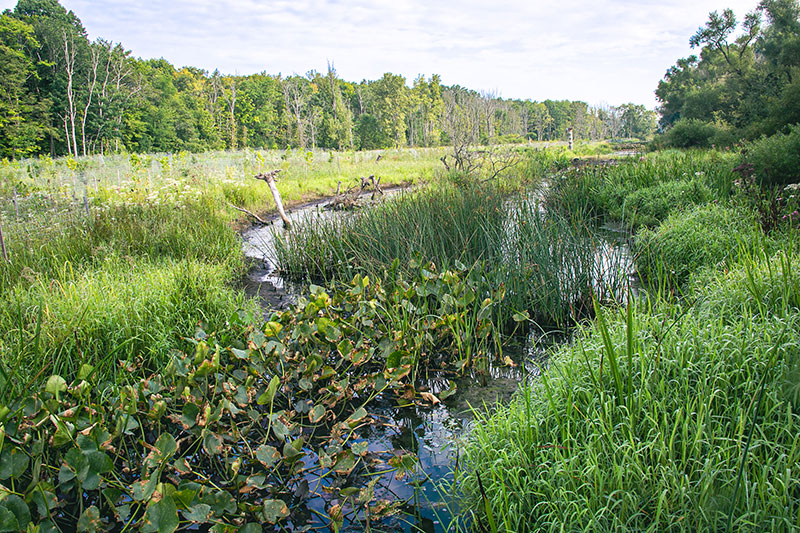
©David Ike Photography
What was once a straightened ditch is now a multi-threaded channel and oxbow wetland system featuring vernal pools, large woody debris habitat, a connected and functioning floodplain, and a living fence to keep out adjacent invasives. We’re pretty sure the creek’s new conditions would garner the approval of its namesake, who just happen to have a lodge at the confluence with Bass Lake, and with its abundant instream and riparian habitat, it is certainly attracting many creatures. For more information, please contact Kevin Grieser.
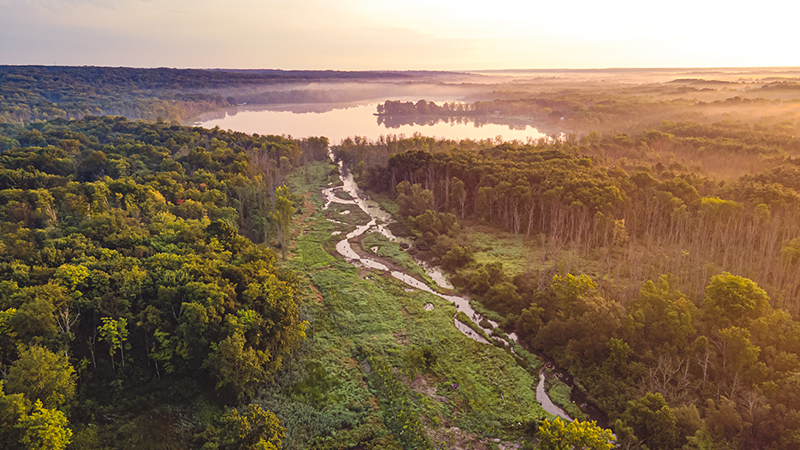
©David Ike Photography
Something to Quack About
We’re thrilled to announce that construction has begun on the restoration of Wild Duck Pond in Ridgewood, New Jersey. A popular spot for picnics, walks, and ice skating, Wild Duck Pond is part of Saddle River County Park, a linear park system that meanders with the Saddle River. Over the last few decades, the pond had become disconnected from the River, which had provided it with surface flow. To continue providing water to the pond, the County installed pumps that have become a maintenance burden and are unreliable. As a result, the pond began to experience high nutrient loads, algal blooms, and fluctuating water levels. Working with the County and our team member, the Louis Berger Group, we developed a restoration design to enhance the pond’s ecological function while improving its aesthetics and reducing its maintenance costs. Informed by the stormwater management and ecology goals of the County’s recent Parks Master Plan, the design includes a new at-grade pump system, a new pond liner, and a series of wetlands that filter the pumped water and stormwater through native vegetation before it enters the pond. Construction will wrap in 2022, and once it does, Ridgewood residents and visitors will have a rejuvenated pond that provides the same recreational amenities plus the added benefits of diverse wildlife habitat, improved water quality, and a robust, living model for future ecological restoration initiatives. For more information, please contact Kevin Dahms.
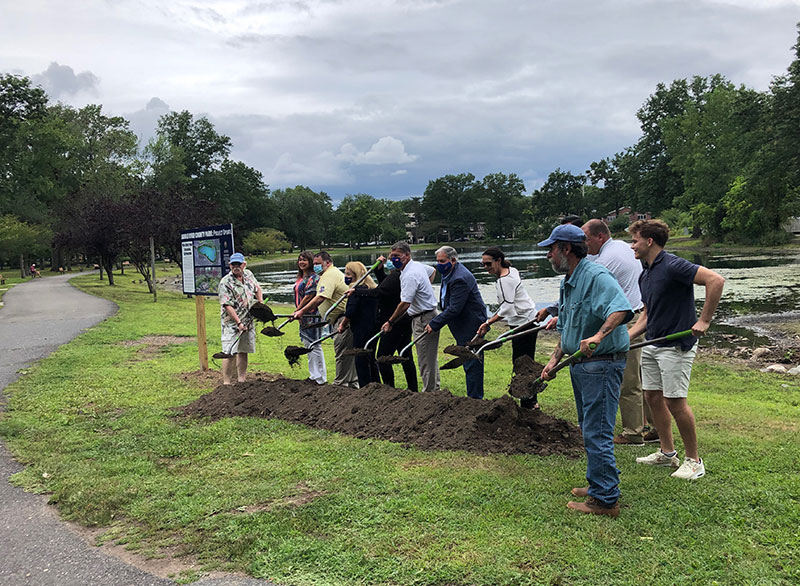
Breaking ground at Wild Duck Pond
A Reason to go Back to the Office
Set to become the world’s first developer-driven Living Office Building, the five-story, mixed-use PAE Building in Portland, Oregon is just about ready to open its doors! Designed by ZGF Architects and PAE Consulting Engineers—a future occupant of the building—the 58,700-square foot structure will produce 105 percent of its energy needs and meet its potable water needs from harvested rain and internal water recycling.
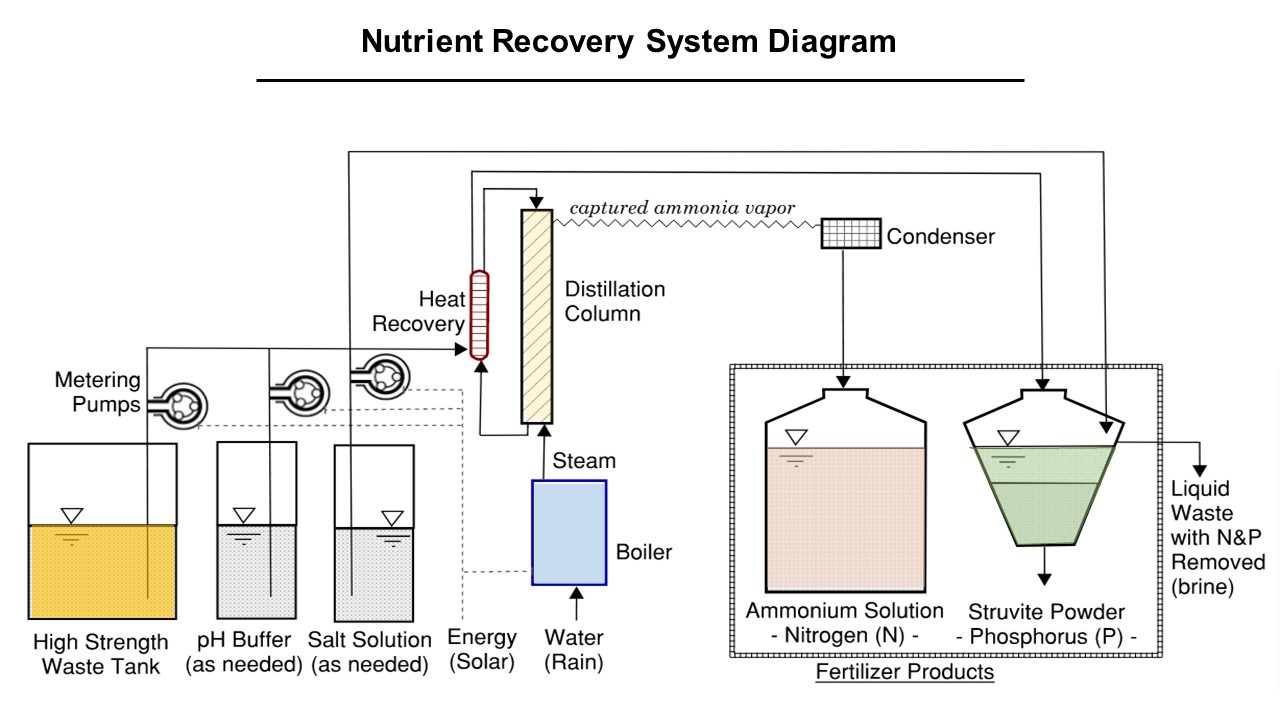
Nutrient Recovery System Diagram
The building demonstrates many sustainable design solutions, including Biohabitats-designed, onsite systems for harvesting rainwater for potable water supply, treating greywater for reuse in toilet flushing and irrigation, and recovering nutrients from high strength waste to produce retail grade fertilizer! For more information about this project contact Pete Muñoz.
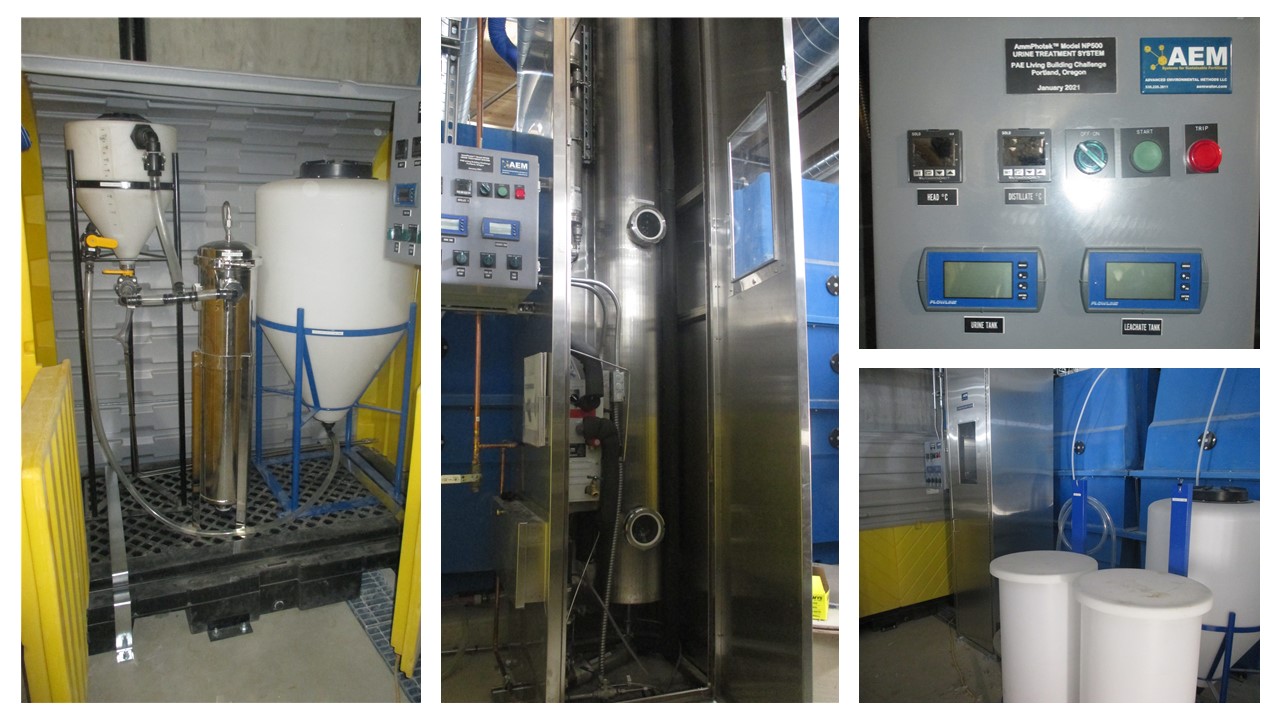
The building's Nutrient Recovery System's product vessels (L) distillation column (C) control panel (Top R) & compost bins for toilet waste (bottom R)
Bringing Nature-Based Design to the Lowcountry of South Carolina
The Lowcountry of South Carolina is known for its historic cities and communities, stunning subtropical coastal environment, rich cultural heritage, and booming tourism. Charleston, along with other Lowcountry communities like Beauford, Bluffton and Hilton Head, are experiencing a tremendous amount of growth. The combination of rapid development, unbridled wetland fill, historically inadequate stormwater management policies, and a changing climate are leaving many communities in and around Charleston vulnerable to flooding from even relatively minor storm events. To begin addressing these issues, the City of Charleston recently hired Biohabitats to develop several nature-based flood resiliency projects for Johns Island and the Church Creek Basin.
Johns Island, a precious national resource close to the booming city of Charleston SC, still retains live oaks dripping with Spanish moss that characterized the island hundreds of years ago. As part of the Gullah Geechee Heritage Corridor, its preservation and rural character contribute to its historic and cultural significance. But today, development pressure has exceeded the ability of the flat, sea island topography to move water to the tidal rivers that surround it. Flooding from stormwater and tidal creeks is frequent and severe. Biohabitats is currently working with WK Dickson and the Water Institute of the Gulf to finalize the Johns Island Restoration Plan to Improve Flood Resiliency, a stormwater and resiliency masterplan that focuses on the area within the John’s Island urban growth boundary. Funded in part by the National Fish and Wildlife Foundation, the masterplan aims to identify potential ecosystem restoration projects, identify existing key drainage and natural assets for preservation, and provide guidance on how to best implement recommendations. For more information, please contact Jessica Norris.
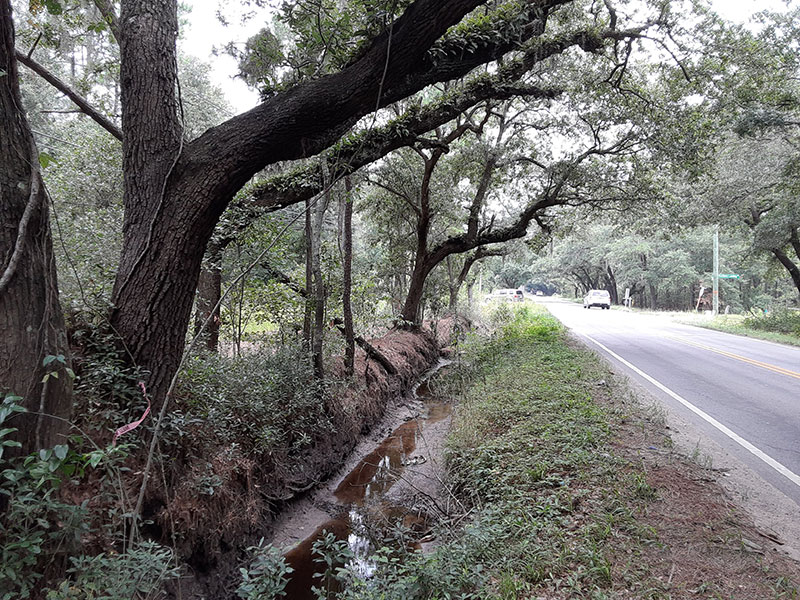
Johns Island, SC
Biohabitats is also teamed with WK Dickson to develop a nature-based design to address the flooding issues associated with the Barberry Woods community on Johns Island. One of the primary goals of the Barberry Woods Drainage Improvement Project is for the City to model a new paradigm shift away from grey infrastructure to an approach that prioritizes nature-based strategies to mitigate flooding while providing multiple ecological and community benefits. With concept plans completed and vetted by the community, the project team is about to embark with final design. For more information about this project, please contact Jim Cooper.
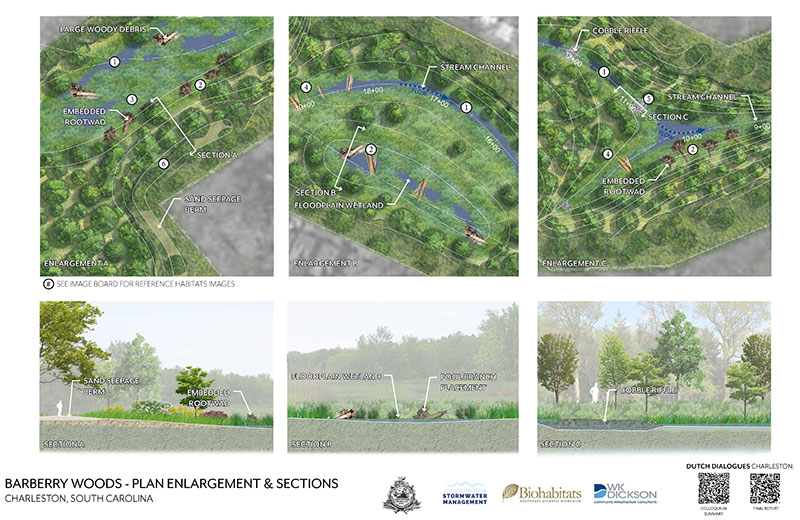
From the Barberry Woods concept plan.
Biohabitats is working with the City of Charleston on the Church Creek Flood Storage and Resiliency Action Plan. The plan will identify, evaluate, and prioritize opportunities to implement nature-based solutions and green infrastructure to protect the basin, promote community resilience, improve recreation and connectivity to natural spaces, and enhance ecosystem services and hydrological function. The project involves two primary components: evaluating and developing green infrastructure installations on residential properties that have been acquired by the City for flood mitigation; and identifying and developing nature-based approaches, such as floodplain, wetlands, bioretention, and stream re-naturalization, on larger properties to create regional stormwater storage and native habitat. The project embodies the design approach that came from the Dutch Dialogues: use water to its advantage. “We’re trying to convert this into some kind of passive recreation space, with water storage and space for native habitat including bald eagles,” Matt Fountain, Director of Stormwater Management for the City said. For more information contact Chris Streb.
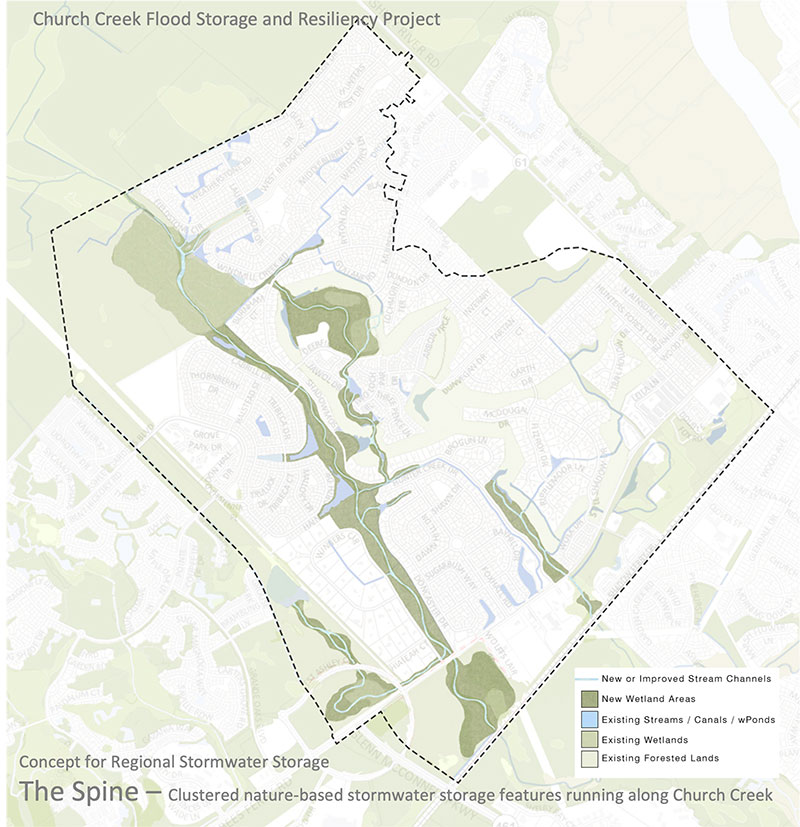
A Decision Tool for Living Shorelines in South Carolina
Imagine owning or managing waterfront property and wanting a nature-based solution to protect it and enhance its resilience over time. Would you know where to begin? Thanks to The Nature Conservancy of South Carolina property owners, community planners, coastal managers and restoration practitioners in the Palmetto State will soon have help from a web-based decision support tool to determine the feasibility of living shorelines in specific locations. For help in creating this tool, TNC turned to Biohabitats. We believe living shorelines are powerful tools to proactively protect estuarine shorelines, and we’re thrilled to apply our 30+ years of experience assessing, designing, and constructing living shorelines throughout the mid-Atlantic region. Biohabitats is leading a team of engineers and ecologists in collecting data, analyzing shoreline energy, and creating the data layers that form the foundation of the tool. The “SC Living Shoreline App” will allow users to visualize important shoreline attributes and will offer preliminary guidance on suitability for living shorelines and other nature-based solutions. Team members Water Environment Consultants and Geosciences Consultants helped us create key data layers. With its extensive estuarine shoreline habitat, South Carolina is in an excellent position to take advantage of living shorelines to protect its salt marshes and improve coastal resilience. For more information, contact Jessica Norris.
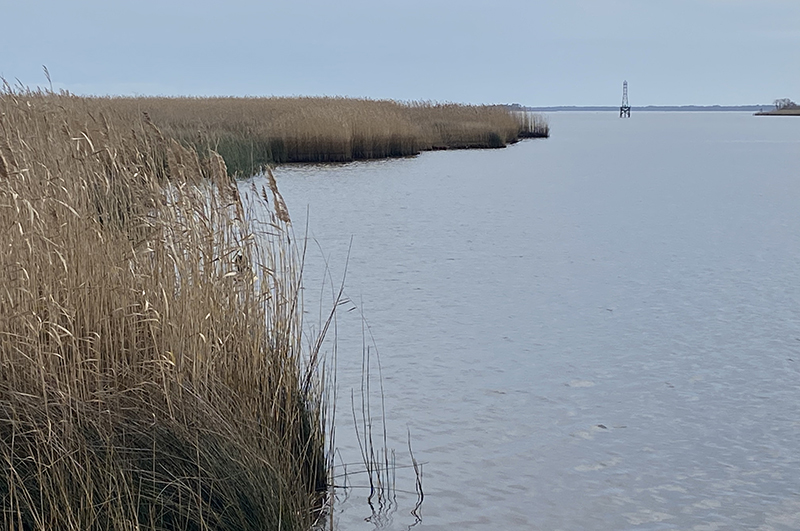
Great Parks with a Promising Future
Situated at the intersection of plains and prairie at the southern end of glaciation, Hamilton County, Ohio, and its surroundings have a treasure of their own in their diverse inventory of parks, nature preserves, and conservation areas. Great Parks of Hamilton County (GPHC) is the public conservation agency responsible for managing these ecological gems, which include 22 parks and preserves. Under a mandate to manage at least 80% of their 17,733 acres of land in a natural state, GPHC places conservation as central to its mission. In 2019, while continuing to pursue that mission and aiming to improve park connectivity and access and inspire the next generation of environmental stewards, GPHC worked with a team led by MKSK to develop a 10-year master plan. As the planning effort moved into concept-level plans for each park, we joined the planning team and created an ecological framework—a guiding document—to direct the approach to conservation and natural resource management so that it yields ecological resilience. The framework catalogs and recommends management actions to protect and restore specific natural resources, establishes system-wide goals and management best practices for each ecological community present in the parks, and provides advice for addressing specific, system-wide challenges. The GPHC 2020-2030 Park and Facility Master Plans have just been released, and since they’ve been built around a framework of ecology, they will enable GPHC to further advance its legacy as guardians of the region’s rich natural treasures. For more information, please contact Jessica Norris.
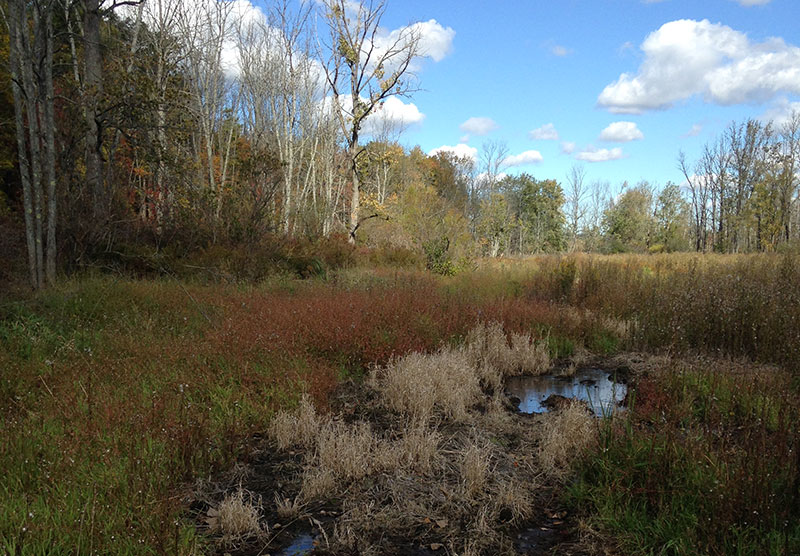
Seepage wetlands in one of Hamilton County's park properties.
Freetown Farm: Demonstrating Stewardship at its Doors
The nonprofit Community Ecology Institute fosters socially and ecologically healthy communities by bringing people together and deepening their connections to each other and the natural world. They pursue this mission by demonstrating tangible, community-based actions that enhance green infrastructure, ecosystem services, and human well-being. In 2019, CEI founded Freetown Farm, an organic farm in Columbia Maryland that offers experiential education related to happy, healthy, and sustainable living. The farm’s name honors the property’s African American history. It is located at the intersection of three locations on the Freetown-Simpsonville Legacy Trail, known to have been part of the Underground Railroad. The area became known as Freetown in the mid-1800s, when a local landowner freed and gave land to 17 people he had previously enslaved. Today, Freetown Farm is surrounded by suburban development and a public high school. When it rains, stormwater swiftly flows from the hard surfaces of the school through the farm property, and into a local tributary. Freetown Farm is demonstrating stewardship in the management of its property. Earlier this year, we worked with CEI to develop an ecological master plan for the Freetown Farm campus that would improve its ecological value and optimize its potential to educate visitors.
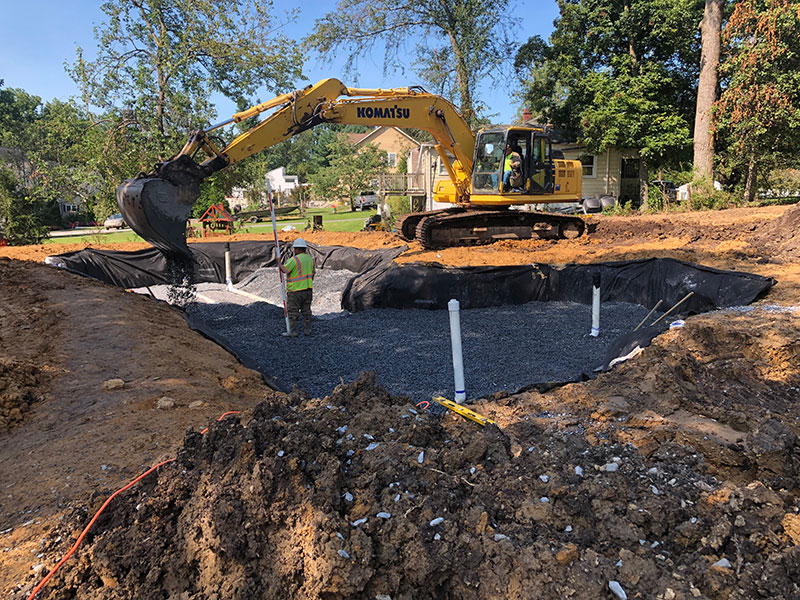
A bioretention system under construction at the entrance to Freetown Farm.
The plan, which provided a foundation for all future campus improvements, also included an early action implementation project to demonstrate a regenerative approach to treating and managing stormwater. CEI contracted both Howard EcoWorks and Triangle Contracting to build the initial project and Biohabitats provided oversight and inspection services during construction. We’re thrilled to have just wrapped construction on that project, a bioswale and bioretention system at the farm’s entrance. Freetown Farm’s experiential environmental education now begins the minute visitors arrive, as they will witness stormwater best management practices at work and have an opportunity to learn how native vegetation can be used to slow down stormwater, filter out pollutants, and add beauty and biodiversity even in densely populated communities. For more information about this project, please contact Jim Favret.
Nonprofit Will Demonstrate and Live its Values in New Headquarters
The Stanley Center for Peace and Security is a nonprofit organization that forms partnerships to drive policy progress toward halting the use and spread of nuclear weapons, preventing mass violence and atrocities, and mitigating climate change. The Center’s new headquarters, in a renovated former library in Muscatine, Iowa, reflects the organization’s commitment to mitigating climate change. The project aims to become the first building to achieve Living Building Certification in Iowa, and we are thrilled to have contributed our expertise in sustainable water infrastructure to the design team led by Neumann Monson Architects and including landscape/civil consultant, Environmental Consulting & Technology, Inc.
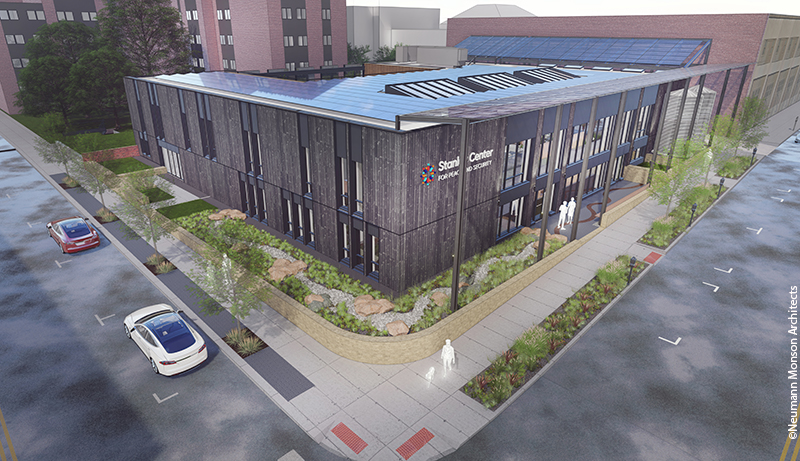
©Neumann Monson Architects
An innovative rainwater harvesting and treatment system, which includes inlet filtration and a potable water treatment skid, enables the building to reuse water captured from the site (including its rooftop and PV panels) to meet all of its potable and non-potable water demands. When it opens, the renovated building will model sustainable practices in Iowa and raise awareness about the need for collective action on climate change. For more information, please contact Pete Muñoz.
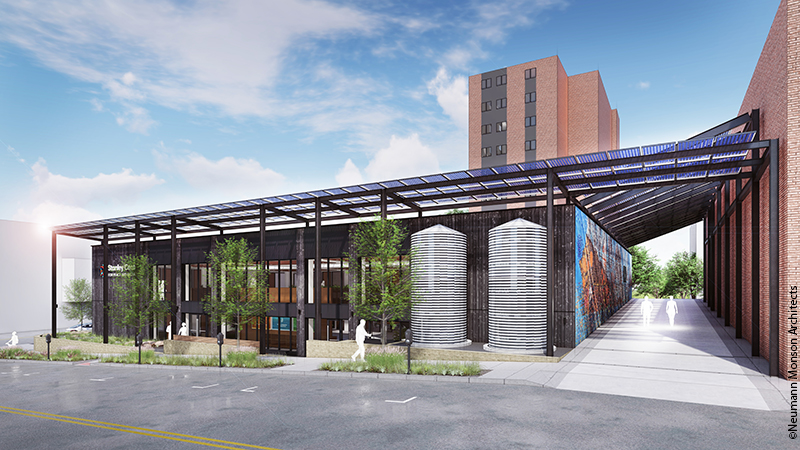
©Neumann Monson Architects
Over the Bend!
Construction is complete and native vegetation is in the ground and growing on what was once a frequently flooded farm field along the Sandusky River in Freemont, Ohio. Thanks to an ecological restoration project undertaken by the Black Swamp Conservancy and funded by the State’s H2Ohio program, the site, now known as Redhorse Bend Preserve, has been transformed into a complex mosaic of wetland, riparian, and meadow habitat.
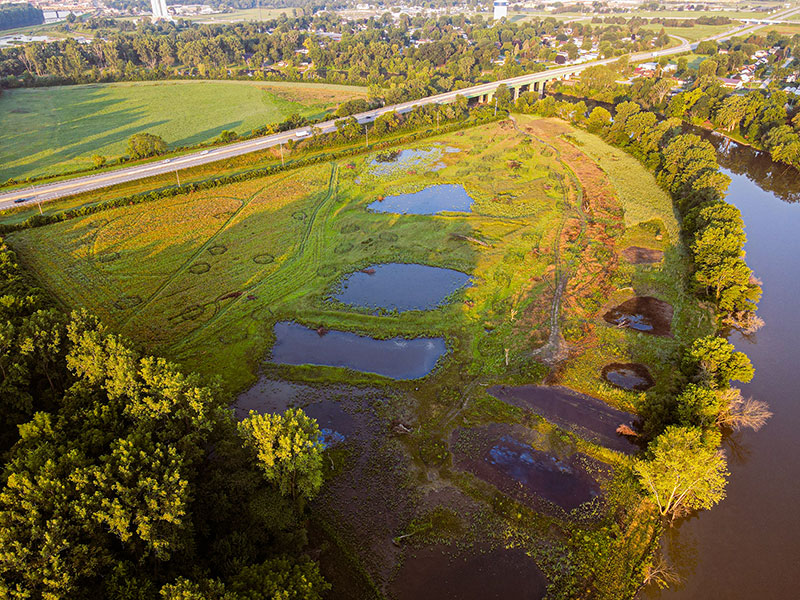
Redhorse Bend ©David Ike Photography
It will ultimately become a publicly accessible nature preserve, and in the meantime, it is already providing habitat, improving water quality, and adding beauty and biodiversity to the region. For more information about this project, please contact Kevin Grieser.
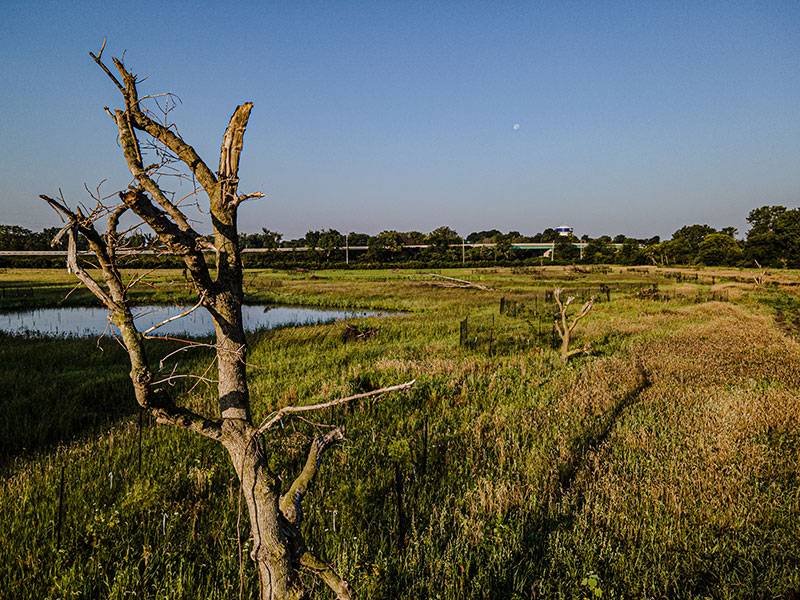
Redhorse Bend ©David Ike Photography
Things Flow As Planned in Downtown Columbia, MD
In 2013, as part of an integrated planning team, we helped the Howard Hughes Corporation integrate ecological restoration and regenerative design into a master plan for Downtown Columbia. Located in the densely populated Baltimore/Washington corridor, Columbia ultimately drains to the Patuxent River, a major tributary to the Chesapeake Bay. As master plan shifted to implementation, we have worked with the Howard Hughes Corporation to restore more than 30 acres of forest, five thousand linear feet of stream, and two acres of wetlands. We visited downtown Columbia after a recent heavy storm as part of our ongoing mitigation monitoring efforts, and we’re pleased to report that the restored tributary and its associated wetlands were performing beautifully, slowing down stormwater and growing increasingly biodiverse and beautiful. For more information about this work, please contact Sarah Roberts.
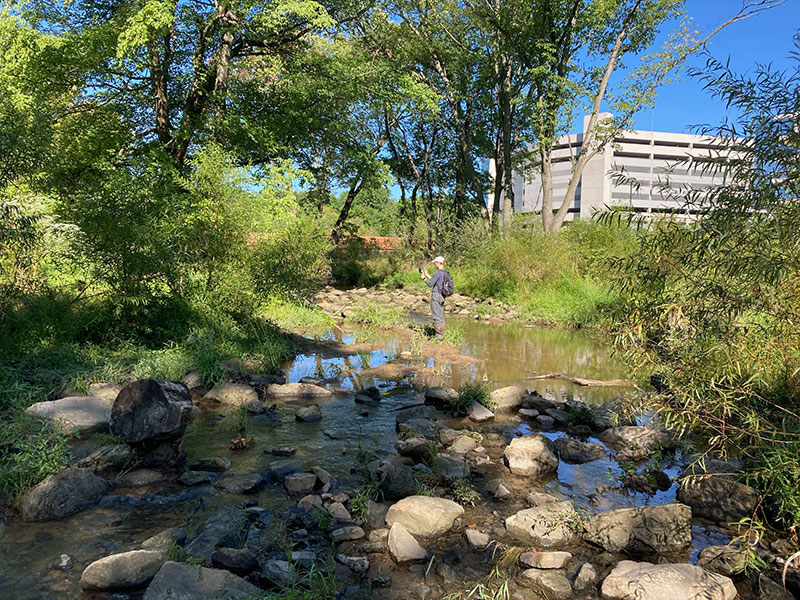
Conducting monitoring at a restoration site in downtown Columbia, MD
Award-Winning Work
Chattahoochee RiverLands, a project for which we served as ecological design and planning consultant on the team led by SCAPE, was recognized in the 2021 ASLA-NY Design Awards. The project earned an Honor Award for Analysis, Research, Planning & Communications.
This summer Loom House, the first renovated home to achieve Living Building Challenge certification, received a 2021 Housing Award from the American Institute of Architects. As the water consultant on a design team led by the Miller Hull Partnership, we developed the home’s innovative water harvesting and onsite wastewater treatment systems. This AIA Housing Award recognizes homes that emphasize the importance of good housing as a necessity of life, a sanctuary for the human spirit, and a valuable natural resource.
Earlier this year, Georgia Tech’s Kendeda Building for Innovative Sustainable Design became the first building in the state of Georgia-and the 28th in the entire world-to be certified as a Living Building. In addition to being named a 2021 AIA COTE Top Ten Award winner by the American Institute of Architects, the project was recently shortlisted in the sustainable building category of Dezeen Awards 2021.
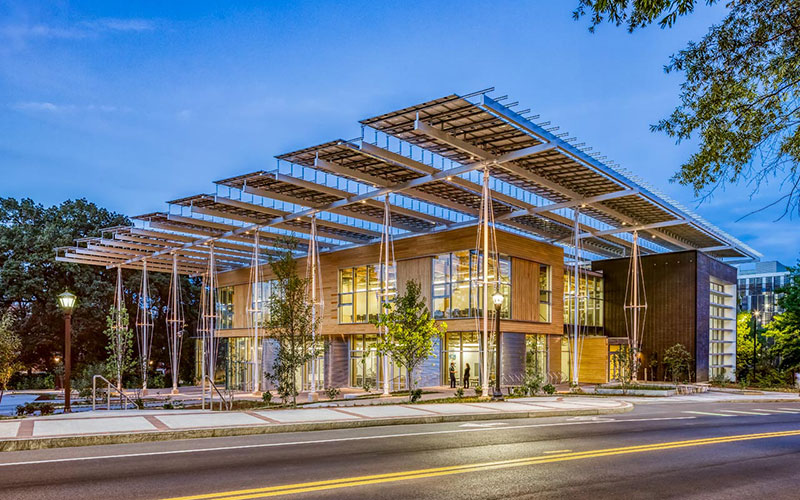
Kendeda Building for Innovative Sustainable Design ©Jonathan Hillyer
Places
On October 1st, as part of the American Shore and Beach Preservation Association’s 2021 National Coastal Conference in New Orleans, Senior Scientist Tom Denbow and colleagues from Baird and Tetratech will present a workshop on the H2Ohio Sandusky Bay Restoration Initiative Nutrient Reduction Wetlands Project, led by The Nature Conservancy of Ohio. They will share an overview of specific project designs aimed at restoring water quality by creating wetlands to enhance nutrient retention/assimilation functions, reduce sediment resuspension, and create habitat. Ultimately the Initiative is aimed at improving public health and safety, ecosystem function, and tourism in the 65-square-mile Sandusky Bay.
The Bayou Preservation Association’s 18th Annual Symposium will be held virtually on October 6-7. This year’s event will feature a presentation by Senior Landscape Ecological Planner and Designer, Jennifer Dowdell, on “Urban Ecology Frameworks for Resilience Planning.” To register for the Symposium, click here.
The South Carolina Native Plant Symposium on November 5-7 in Charleston, South Carolina. Biohabitats President, Keith Bowers, will deliver a talk entitled “Restoring the Future in a Changing World.”
Several Biohabitats team members plan to virtually attend the Bioneers 2021 Conference – Between Worlds, Emergence in an Emergency, November 11-13. We hope you’ll join us!
As a Board Member of the Landscape Architecture Foundation, Keith will be attending the LAF 36th Annual Benefit, November 19, in Nashville, TN. Keith will stay in Nashville to attend the American Society of Landscape Architects Annual Conference 19-22.
People
Meet our Newest Team Members!
Earlier this year, we welcomed Construction Project Team Leader, Jeff Payson, who is based in Biohabitats’ Cascadia Bioregion; Water Resources Engineer, Sarah Emrich, who works in the Chesapeake/Delaware Bays Bioregion; and Geospatial Analyst/Environmental Scientist, Hanna Harper, who is based in Biohabitats Southern Rocky Mountain Bioregion. But there is so much more to a person than a title. Did you know, for example, that one of our new team members is an adrenaline junkie? Or that one discovered passion for environmental work while living with an indigenous Māori family in New Zealand? Can you guess which one grew up in a region known as the backdrop for Old Milwaukee beer commercials starting comedian Will Ferrell? You can find out on these posts about Hanna, Sarah, and Jeff on the Rhizome blog!
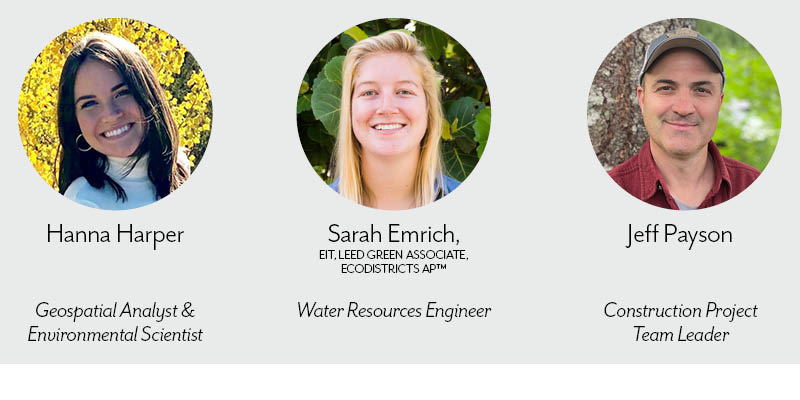
Who says Marketing isn’t Meaningful?
Imagine if you could use your communication skills to bring nature-based solutions to more communities. What might it feel like to know that your knack for writing, design, understanding audiences, and managing details can advance ecological restoration and design? Or climate resilience? If this thought exercise appeals to you, you might want to consider joining our team! Our marketing team is hiring for the positions of Proposal Assistant (based in Portland, remote optional) and Proposal Manager (based in Baltimore, MD, remote optional). To learn more, please visit the Careers page of our website.

